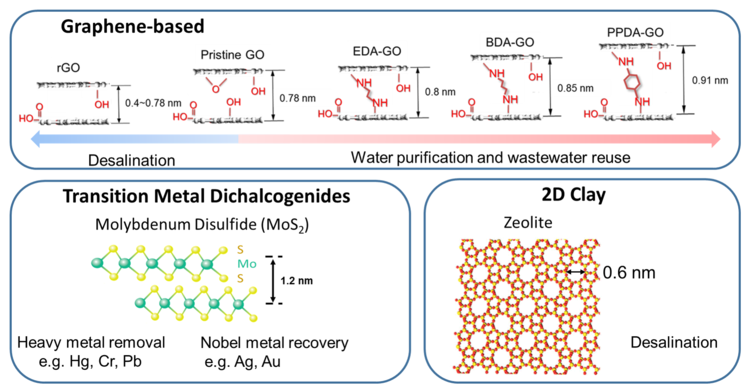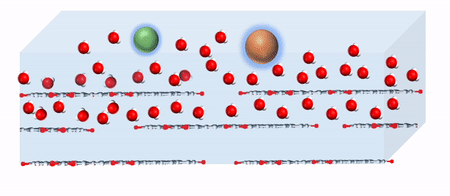2D Nanomaterial Membranes with Enhanced Transport and Selectivity
Membrane-based separations have been increasingly applied to address the challenges of water scarcity and pollution facing the entire human society. The inherent limitations of conventional membrane materials (e.g. fouling and oxidative degradation) inspires the exploration of novel membrane materials. An emerging class of high-performance membranes is layer-stacked membranes assembled by two-dimensional (2D) nanomaterials (e.g. graphene-based, MoS2). The nanochannels formed between neighboring nanosheets serve as the water transport paths (functionally equivalent to nanopores in porous membrane materials), enabling the rejection of unwanted ions and molecules that are larger in size. The precise selectivity of layer-stacked membrane, achieved by finely controlling the interlayer spacing, offers an exciting opportunity in membrane-based separations.
Related Publication:
1. Zheng, S.; Tu, Q.; Wang, M.; Urban, J. J.; Mi, B., Correlating Interlayer Spacing and Separation Capability of Graphene Oxide Membranes in Organic Solvents. ACS Nano 2020.
2. Mi, B.; Zheng, S.; Tu, Q., 2D graphene oxide channel for water transport. Faraday Discuss. 2018, 209, 329-340.
3. Wang, Z.; Tu, Q.; Zheng, S.; Urban, J. J.; Li, S.; Mi, B., Understanding the aqueous stability and filtration capability of MoS2 membranes. Nano Lett. 2017, 17, 7289-7298.
3. Zheng, S.; Tu, Q.; Urban, J. J.; Li, S.; Mi, B., Swelling of graphene oxide membranes in aqueous solution: characterization of interlayer spacing and insight into water transport mechanisms. ACS Nano 2017, 11, 6440-6450.
4. Zheng, S.; Mi, B., Emerging investigators series: silica-crosslinked graphene oxide membrane and its unique capability in removing neutral organic molecules from water. Environmental Science: Water Research and Technology 2016, 2, 717-725.




